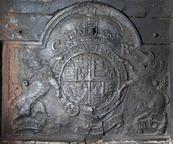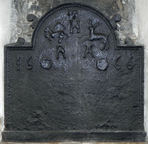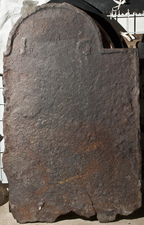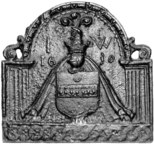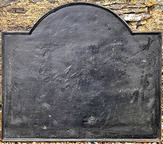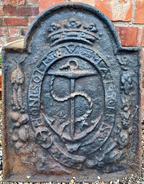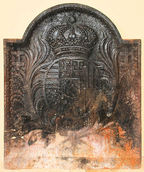-
350
Description: Arched rectangular shape; cavetto edging; armorial; Stuart English royal arms within a circular garter; crown, motto and supporters (crowned lion and unicorn); initials separated by crown.
Notes: An early casting of a widely copied fireback. A later copy with an inserted, probably spurious, date is no. 1303.
Copies of this fireback are known.
Inscription: C R / HONI SOIT QVI MAL Y PENSE / DIEU ET MON DROIT
Arms: English Stuart royal
- Decoration tags:
- rectangular with round arch (shape)
- cavetto (edging)
- whole carved pattern
- armorial
- royal
- text
Manufactured: in the mid-17th century in England.
Current location: Knole, Sevenoaks, Kent, England.
(part of the National Trust museum group)
- Attached to series:
- Carolean royal armorial firebacks
- Stuart royal armorial firebacks
-
974
Description: Arched rectangular shape on a plain plinth; scalloped cavetto-moulded edging (top and sides); initials in triad within arch; date split in top corners; unidentified stamp top centre; hound stamp above letter 'R', stag stamp above letter 'A'; annulet stamp repeated inside each half of the date; flat scrolled protuberance on each side of arch; smaller protuberance above each shoulder.
Notes: The initials are likely to be those of a husband and wife, the stag and hound possibly associated with the husband's occupation. The protuberances are seen in different forms on few firebacks of the same period.
Inscription: RHA / 16 66
- Decoration tags:
- rectangular with round arch (shape)
- scalloped cavetto (edging)
- carved stamps
- individual letters
- individual numbers
- text
- animals
- objects
Manufactured: in 1666 in England.
Current location: Bishop's House, Norton Lees Lane, Sheffield, South Yorkshire, England.
(part of the Museums Sheffield museum group)
- Attached to series:
- Miscellaneous stamp firebacks
- Date & initials firebacks
- Loop edged firebacks
-
998
 pl 66 brede place a.jpg) ? x ? mm
? x ? mmDescription: Arched rectangular shape; fillet edging with a wider fillet within upon which are regularly-spaced beads each set on disc and joined by a thin line; shield, Garter, helm, mantling, crown and lion crest, with crowned lion and unicorn supporters; metal strapping around main rectangle.
Notes: A damaged example with unusual supporting bands. Formerly at Brede Place, East Sussex.
Inscription: HONI SOIT QVI MAL Y PENSE
Arms: English Stuart royal
- Decoration tags:
- rectangular with round arch (shape)
- fillet (edging)
- whole carved pattern
- armorial
- royal
- text
Manufactured: in the early- to mid-17th century possibly in the Weald area of England.
Current location: not known.
Citation: Shuffrey, L. A., 1912, The English Fireplace, London, Batsford.
- Attached to series:
- Stuart royal armorial firebacks
-
919
Description: Arched rectangular shape; rope edging (top and sides); undulating floriate design across top of rectangle, below which are alternating roses (4) and ?crowned cross stamps (5); the same cross and rose stamps decorate the arch, three crosses on each side of a rose at the top; at the base of the arch is a row of four stamps formed of a double figure-of-eight joined by opposed concave curves; the same stamps (3), rotated 90 degrees, are arranged in a row down the left side of the plate.
Notes: Similar undulating floriate designs have been seen on late-medieval and sixteenth century stools, suggesting a possible source. A fireback with the same loop stamps bears the same date using the same numerals but impressed in reverse. Unusually, the decoration down the left side is not repeated down the right side.
Inscription: 1594
- Decoration tags:
- rectangular with round arch (shape)
- rope (edging)
- simple stamps
- carved stamps
- individual numbers
- text
- plants
- objects
Manufactured: in 1594 in the Weald area of England.
Current location: Weald and Downland Living Museum, Singleton, West Sussex, England.
(part of the Weald and Downland Living Museum museum group)
- Attached to series:
- Loop stamp (early) series
- Furniture stamp firebacks
-
1143
Description: Fragment, left side missing; arched rectangular shape; fillet edging (top and sides visible); initials IG widely spaced in arch.
Notes: Previously at Bream Court Farm, Newland, Gloucestershire.
Inscription: I G
- Decoration tags:
- rectangular with round arch (shape)
- fillet (edging)
- simple stamps
- individual letters
- text
Manufactured: in the 17th century possibly in the Forest of Dean area of England.
Current location: Dean Heritage Centre, Camp Mill, Soudley, Gloucestershire, England.
- Attached to series:
- Initials only firebacks
-
691
Description: Arched rectangle; arch with egg and dart, ovolo edging, resting on rectangle shoulders and sides with triple fillet edging, a single fillet edged panel beneath; bottom panel, guilloche pattern of 12; main panel: shield, helm, crest, coronet and mantling of the Wynter/Wintour family of Lydney, Gloucestershire; the initials above the date, both split by the helm and coronet; on either side of the shield, Ionic pilasters; above the rectangle shoulders, a scrolled bracket each side, supporting the arch.
Notes: Wynter: Sable, a fess ermine, in chief a crescent for difference; crest: out of a ducal coronet, or, a cubit arm in armour erect, proper, garnished of the first, in the gauntlet three ostrich-feathers. The arms are likely to be those of Sir John Wynter, who owned several furnaces in the Forest of Dean. Formerly at Watts House, Bishop's Lydeard, Somerset, and before that at The Priory, Taunton.
Inscription: I W / 16 30
Arms: Winter/Wintour of Lydney, Gloucestershire
- Decoration tags:
- rectangular with round arch (shape)
- ovolo, egg and dart (edging)
- whole carved pattern
- individual letters
- individual numbers
- armorial
- text
Manufactured: in 1630 in the Forest of Dean area of England.
Current location: Horniman Museum, 100 London Road, Forest Hill, London, England.
Museum number: 6.249 (part of the Horniman Museum museum group)
- Attached to series:
- Personal armorial firebacks
- Date & initials firebacks
-
1245
Description: Arched rectangular shape; cavetto-moulded edging; no decoration.
Notes: A plain base board.
- Decoration tags:
- rectangular with round arch (shape)
- cavetto (edging)
- whole carved pattern
Manufactured: in England.
Current location: not known.
- Attached to series:
- Base boards
-
1087
Description: Arched rectangular shape; cavetto-moulded edging; central fouled anchor within a Garter surmounted by a ducal coronet; fructal swags to each side.
Notes: The anchor may relate to the office of Lord High Admiral who, in the third quarter of the 17th century was James, Duke of York (afterwards King James II). Another example was sold at Christie's auction 12 Oct 2010 lot 109 (£500). A variant with a viscount's coronet is at Chastleton House, Oxfordshire.
Copies of this fireback are known.
Inscription: HONI SOIT QUI MAL Y PENSE
- Decoration tags:
- rectangular with round arch (shape)
- cavetto (edging)
- whole carved pattern
- heraldic
- text
- objects
Manufactured: in the mid- to late-17th century in England.
Current location: Stratford upon Avon, Warwickshire, England.
- Attached to series:
- Miscellaneous royal firebacks
-
820
Description: Arched rectangular shape; wide fillet and egg-and-dart ovolo edging; central oval armorial with fillet edging, palm fronds on each side, tied below, a crown above; in each top corner, the cross of Lorraine.
Notes: The arms are those of Duke Leopold I of Lorraine, who also bore the titles of King of Jerusalem, Hungary and Aragon, and Duke of Anjou, Bar, Gueldre and Juliers.
Arms: Leopold I, Duke of Lorraine and Bar (1680-1729)
- Decoration tags:
- rectangular with round arch (shape)
- ovolo, egg and dart (edging)
- whole carved pattern
- armorial
Manufactured: in the early-18th century possibly in the Lorraine area of France.
Current location: not known.
- Attached to series:
- Foreign armorial firebacks
-
909
Description: Arched rectangular shape; cavetto-moulded edging;lower centre, crowned bust of King William III above a cartouche, possibly orange branches, with leaves and fruit on each side; above, a putto blowing a trumpet; initials on each side of cartouche; date split between bottom corners.
Notes: A finely detailed image of King William III; the significance of initials is not known. It is possible that the bust of the king, the date, initials and the surrounding branches were carved on a separate pattern which was added to an otherwise simple mould comprising an arched rectangular border and the trumpet-blowing putto before casting. Christie's auction, 25 Feb 2014, lot 184 (£6,000).
Copies of this fireback are known.
Inscription: 16 96 / AC AL
- Decoration tags:
- rectangular with round arch (shape)
- cavetto (edging)
- whole carved pattern
- individual letters
- individual numbers
- historical
- royal
- text
- humans
- plants
Manufactured: in 1696 in England.
Current location: not known.
- Attached to series:
- Miscellaneous royal firebacks
